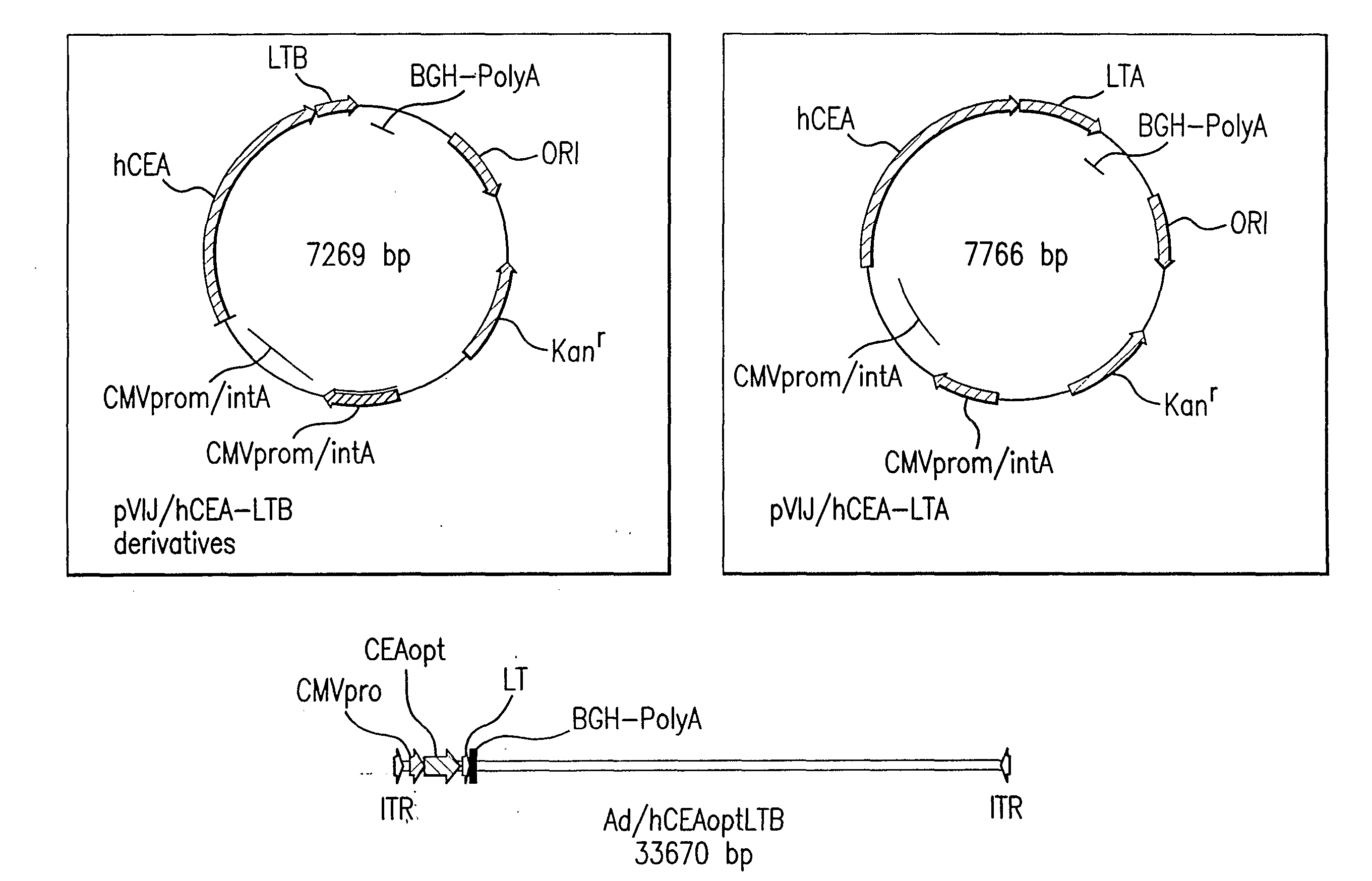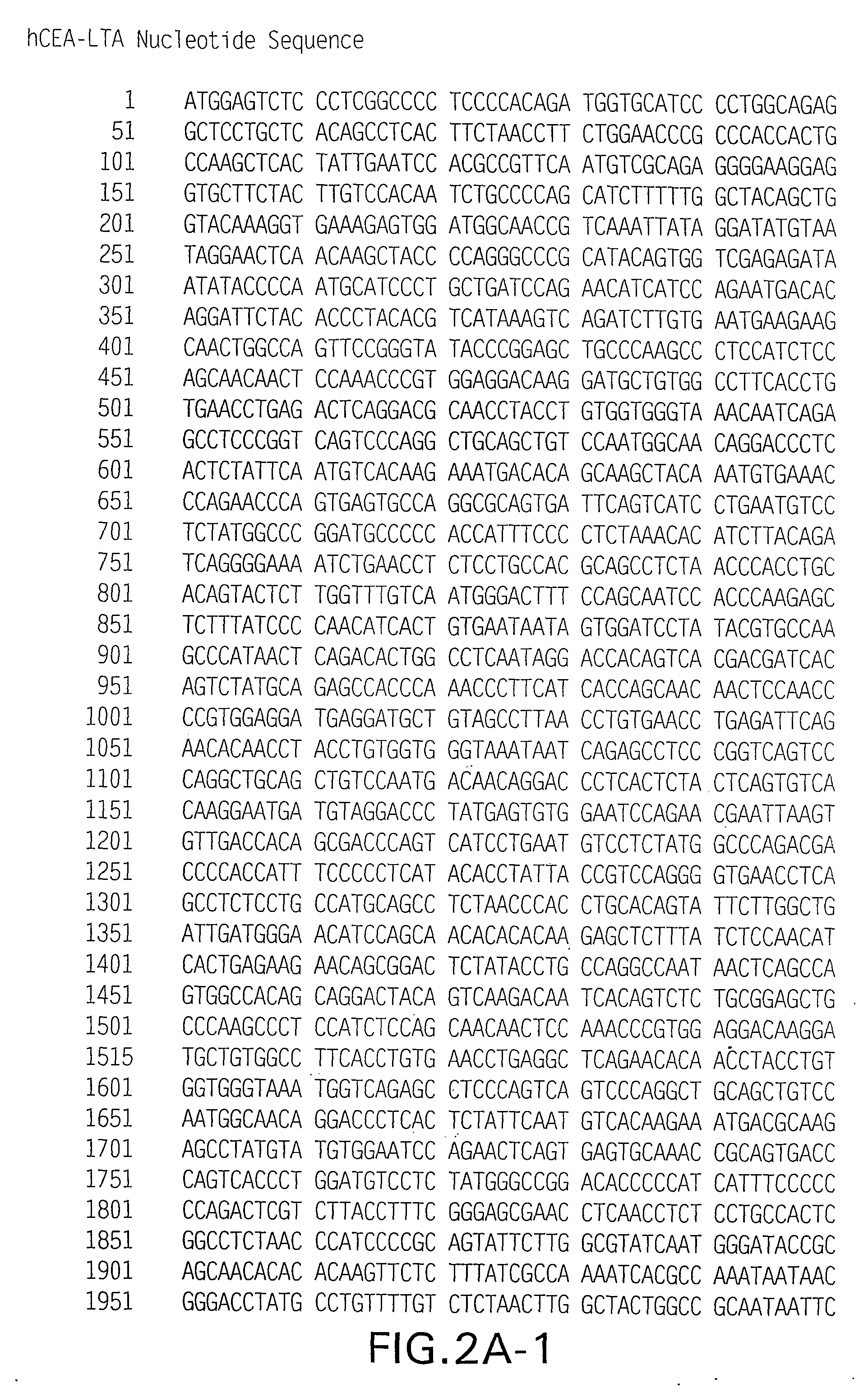Carcinoembryonic Antigen Fusions and Uses Thereof
a carcinoembryonic and antigen technology, applied in the field of cancer treatment, can solve the problems of inability to generate an immune response of sufficient magnitude in the treated individual, hinder the development and commercialization of many vaccines, and inhibit the success of dna-based vaccines, etc., to stimulate the production of antibodies, enhance the immune response, and stimulate the immune response.
- Summary
- Abstract
- Description
- Claims
- Application Information
AI Technical Summary
Benefits of technology
Problems solved by technology
Method used
Image
Examples
example 1
Construction of CEA Fusion Proteins
[0149]To determine the immunogenicity of CEA fusion proteins, a series of vectors were constructed encoding amino acids (hereinafter aa) 1 to 679 of the human CEA protein fused to a panel of selected polypeptides (see EXAMPLE 2). These sequences were chosen in view of their reported immunoenhancing properties, which have been demonstrated in a variety of experimental systems. The CEA fusions were engineered by joining the cDNA of the CEA protein deleted of the GPI anchoring sequence to the foreign polypeptides (exemplary constructs are depicted in FIG. 18A). The tumor antigen was linked to the HSP70, FcIgG or LAMP sequences to determine whether enhancement of antigen uptake or retargeting to the endosomal compartment would lead to an increased immune response. Similarly, fusion to fragment C of tetanus toxin (FrC) or to a minimal domain devoid of potentially competitive MHC class I binding epitopes (DOM, see FIG. 29) (Rice et al. J. Immunol. 169: 3...
example 2
Plasmid Constructs
[0154]pV1J / CEAopt and pV1J / CEA: These two constructs carry the codon usage optimized and wild type cDNA of CEA, respectively. The CEA coding sequence is located between the CMV / intronA immediate early promoter of cytomegalovirus and the bovine growth hormone polyadenylation signal. For generation of pV1J / hCEAopt, plasmid pCR-hCEAopt was digested with EcoRI for 1 hr at 37° C. The resulting 2156 bp insert was purified and cloned into the EcoRI site of plasmid pV1JnsB ((Montgomery et al. DNA Cell Biol 12(9): 777-83 (1993)).
[0155]For generation of pV1J / hCEA, plasmid pCI / hCEA (Song et al. Regulation of T-helper-1 versus T-helper-2 activity and enhancement of tumour immunity by combined DNA-based vaccination and nonviral cytokine gene transfer. Gene Therapy 7: 481-492 (2000)) was digested with EcoRI. The resulting 2109 bp insert was cloned into the EcoRI site of plasmid pV1JnsA (Montgomery et al., supra).
[0156]pV1J / hCEA-LTB and pV1J / hCEAopt-LTB: The codon optimized cDNA ...
example 3
Adenovirus Vectors
[0162]Ad5 / hCEAopt: Plasmid pCR-hCEAopt was digested with EcoRI. The resulting 2156 bp insert was purified and cloned into the EcoRI of the polyMRK-Ad5 shuttle plasmid.
[0163]Ad5 / CEA: The shuttle plasmid pMRK-hCEA for generation of Ad5 vector was obtained by digesting plasmid pDelta1sp1B / hCEA with SspI and EcoRV. The 9.52 kb fragment was then ligated with a 1272 bp BglII / BamHI-restricted, Klenow-treated product from plasmid polyMRK. A PacI / StuI fragment from pMRK-hCEA and pMRK-hCEAopt containing the expression cassette for hCEA and E1 flanking Ad5 regions was recombined to ClaI linearized plasmid pAd5 in BJ5183 E. coli cells. The resulting plasmids were pAd5-hCEA and pAd5-hCEAopt, respectively. Both plasmids were cut with PacI to release the Ad ITRs and transfected in PerC-6 cells. Ad5 vectors amplification was carried out by serial passage. MRKAd5 / hCEA and MRKAd5 / hCEAopt were purified through standard CsCl gradient purification and extensively dialyzed against A105 ...
PUM
| Property | Measurement | Unit |
|---|---|---|
| Immunogenicity | aaaaa | aaaaa |
| Heat | aaaaa | aaaaa |
Abstract
Description
Claims
Application Information
 Login to View More
Login to View More - R&D
- Intellectual Property
- Life Sciences
- Materials
- Tech Scout
- Unparalleled Data Quality
- Higher Quality Content
- 60% Fewer Hallucinations
Browse by: Latest US Patents, China's latest patents, Technical Efficacy Thesaurus, Application Domain, Technology Topic, Popular Technical Reports.
© 2025 PatSnap. All rights reserved.Legal|Privacy policy|Modern Slavery Act Transparency Statement|Sitemap|About US| Contact US: help@patsnap.com



